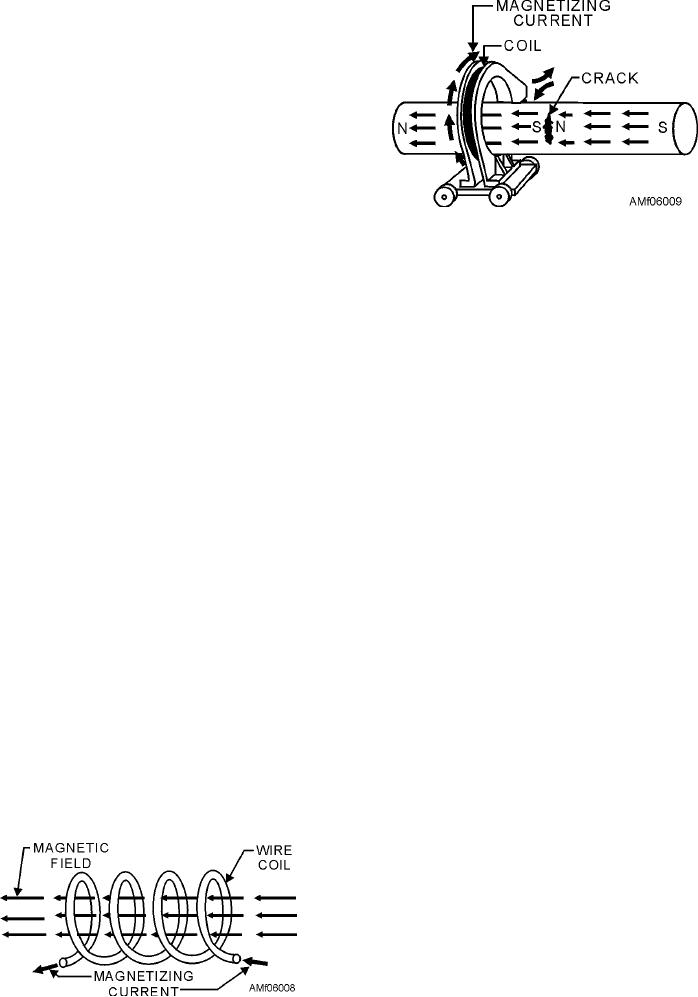
shown in figure 6-8, the magnetic lines of force created
by the magnetizing current concentrate themselves in
the part and induce a longitudinal magnetic field.
Inspection of a cylindrical part with longitudinal
magnetism is shown in figure 6-9. If there is a
transverse discontinuity in the part, such as that in the
illustration, small magnetic poles are formed on either
side of the crack. These poles will attract magnetic
particles, forming an indication of the discontinuity.
Compare figure 6-9 with figure 6-5, and note that in
both cases a magnetic field has been induced in the part
that is at right angles to the defect. This is the most
Figure 6-9.--Coil creates a longitudinal field to show crack in
desirable condition for a reliable inspection.
a part.
ALTERNATING CURRENT.--The use of alter-
are made of magnetic materials, usually combinations
nating current (ac) in magnetic particle inspection is
of iron and iron oxides, that have a high permeability
recommended only for the detection of surface dis-
and low retentivity. Particles that have high
continuities, which comprise the majority of
permeability are easily magnetized by and attracted to
service-induced defects. Fatigue and stress corrosion
the low-level leakage fields at discontinuities. Low
cracks are examples of cracks usually open to the
retentivity is required to prevent the particles from
surface. Alternating current, which must be single
being permanently magnetized. Strongly retentive
phase when used directly for magnetizing purposes, is
particles tend to cling together and to any magnetic
taken from commercial power lines or portable power
surface, resulting in reduced particle mobility and
sources, and is usually 50 or 60 hertz.
increased background accumulation.
DIRECT CURRENT.--Direct current (dc)
Particles are very small and are various sizes. Each
magnetizes the entire cross section more or less
magnetic particle formulation always contains a range
uniformly in the case of longitudinal magnetization.
of sizes and shapes to produce optimum results for the
Magnetic fields produced by direct current penetrate
intended use. The smallest particles are more easily
deeper into a part than fields produced by alternating
attracted to and held by the low-level leakage fields at
current, which makes it possible to detect subsurface
very fine discontinuities; larger particles can more
discontinuities. Generally, direct current is used with
easily bridge across coarse discontinuities, where the
wet magnetic particle methods. In the presence of dc
leakage fields are usually stronger. Elongated particles
fields, dry powder particles behave as though they were
are included, particularly in the case of dry powders,
immobile, tending to remain wherever they happen to
because these rod-shaped particles easily align
land on the surface of a part. This is in contrast to what
themselves with leakage fields not sharply defined,
happens with dry powder particles in the presence of ac
such as those that occur over subsurface discontinuities.
fields. In these fields, the particles have mobility on a
Global-shaped particles are included to aid in the mo-
surface due to the pulsating character of the fields.
bility and uniform dispersion of particles on a surface.
Particle mobility aids considerably the formation of
Magnetic particles may be applied as a dry powder,
particle accumulations (indications) at discontinuities.
or wet, by using either water or a high flash point
PARTICLES AND METHODS OF APPLICA-
petroleum distillate as a liquid vehicle carrier. Dry
TION.--The particles used in magnetic particle testing
powder is available in various colors, so the user can
select the color that contrasts best with the color of the
surface upon which it is used. Colors for use with
ordinary visible light are red, grey, black, or yellow.
Red- and black-colored particles are available for use in
wet baths with ordinary light, and yellow-green
fluorescent particles for use with a black light.
Fluorescent particles are widely used in wet baths,
since the bright fluorescent indications produced at
discontinuities are readily seen against the dark
backgrounds that exist in black light inspection areas.
Figure 6-8.--Magnetic field in a part placed in a coil.
6-8

